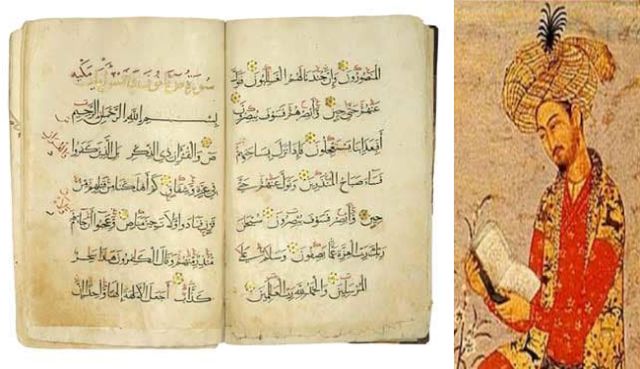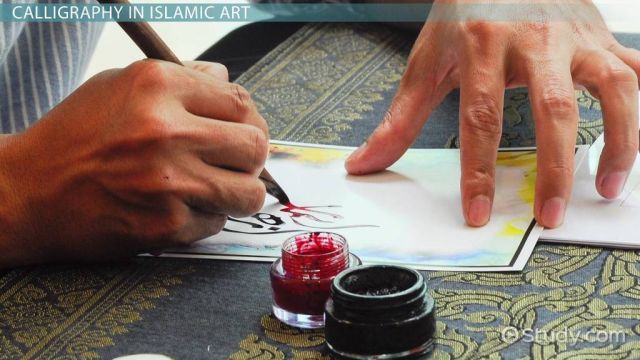
by admin | May 25, 2021 | News
 London : Collectors and connoisseurs of Islamic and Indian art are in for a treat as medieval historical artefacts dating between the 9th and the 19th centuries will be on auction at Christie’s London on Thursday.
London : Collectors and connoisseurs of Islamic and Indian art are in for a treat as medieval historical artefacts dating between the 9th and the 19th centuries will be on auction at Christie’s London on Thursday.
Illustrations from an early “Baburnama”, gilded manuscripts of the Quran, a 17th century painting of Hindu goddess Bagalamukhi, and a pigment-on-paper work showing Mughal emp`eror Jahangir on a lion-hunt, will be some of the works that will go under the hammer at the day-long auction titled “Art of the Islamic and Indian Worlds”.
Many cover a geographical area stretching from India in the east to Al-Andalus in modern Spain in the west, Christie’s said in a statement.
On offer will be an illustration by artist Haydar Kashmiri from an early “Baburnama” — an autobiographical account of Babur (1483-1530), who founded the Mughal empire in the Indian subcontinent in 1526.
The illustration shows a battlefield, but interpreters are divided about which war it depicts, with many pointing to the Battle of Kandahar, Christie’s said.
Another striking work on sale would be a painting of the Hindu goddess Bagalamukhi, dating back to 1630s, attributed to Mughal court artist Payag.
This painting of the deity, believed to be among the 10 avatars of Devi that runs parallel to those of Hindu god Vishnu, holds importance as its provenance relates to Mughal patronage.
The auction focussing on Islamic art also showcases gold illuminated manuscripts of the Quran, with carefully preserved parchments also holding some of the earliest forms of calligraphy.
Also on offer are many iconographical paintings relating to Islamic and Indian mythology and court life, including one where the fourth Mughal emperor Jahangir is seen brandishing his sword in front of a lion in a jungle hunt.
The auction, housing many more artefacts, is preceded by an exhibition at Christie’s London, that started on Saturday.
—IANS

by admin | May 25, 2021 | Arabic, News
 By Mohammed Shafeeq,
By Mohammed Shafeeq,
Hyderabad : Islamic art, especially calligraphy, can play a key role in ada’wah’, or inviting people to understand Islam and clearing misconceptions about it, feels Fareed A. Al-Ali, the head of Kuwait Islamic Arts Centre.
Drawing pictures of human beings is prohibited in Islam, but he believes the beauty of various Islamic arts, including calligraphy, is a powerful tool to attract people and invite them to understand the message of Islam.
Whenever Fareed goes to art exhibitions, people stand in queue to get their names written in his beautiful writing and they preserve it like autographs of a celebrity. Fareed’s writing of Allah’s names in different styles at an exhibition in Egypt attracted the attention of a French national.
“He wanted to know what is Allah and what is Islam. I referred him to Al-Azhar University, where he learnt about Islam and a year later embraced Islam,” Fareed told IANS.
The president of the Kuwait Islamic Arts Centre, who was recently on a visit to India, believes that art exhibitions and workshops are key to spreading the message of Islam and also in removing the misconceptions.
“The beauty of words can make the difference. When they see beautiful words of Quranic ayats (verses), they want to know the meaning and this make them go further and understand Quran,” said Fareed, who has demonstrated his calligraphy skills at the Jaipur Art Summit for the last two years.
The Kuwait Islamic Arts Centre, under the Ministry of Awqaf and Islamic Affairs, has been working for more than 11 years to promote Islamic arts like calligraphy and illumination. It organises workshops and exhibitions and conducts competitions in schools.
He pointed out that the Centre , apart from promoting Arabic calligraphy around the world, was also helping remove the misconceptions about Islam. “Everybody thinks Islam is terror and Islam is a problem… but through art we tell them it is not. We say Islam is peace.
“People in Europe, America and Japan respect Islamic art. We go to their countries and show this is Islam.”
The Centre, working in different ways to nourish calligraphy, focuses on children and publishes a lot of books to make them learn and discover Islam through activities like puzzles and colouring.
He is happy that many young people in Kuwait are taking to calligraphy. “There is huge demand. Many students are on waiting list. Several Kuwaitians take Ijaza (certificate) from renowned calligraphers. More women than men are learning calligraphy,” he said.
Fareed is happy over the efforts being made in India to revive Arabic calligraphy.
In December last year, he inaugurated the Arabic Calligraphy Centre in Hyderabad. This is the second centre opened by Muqtar Ahmed, who teaches calligraphy at the Institute of Indo-Islamic Art and Culture in Bengaluru.
He feels without depending on the government’s help to promote Arabic calligraphy, the rich among the Muslims community should come forward to contribute their mite.
“The rich should put their money in buying calligraphy works. They will also get good returns. A good work which is worth $1,000 today will have a value of $3,000 to 6,000 in 5-7 years. Such works fetch millions in international exhibitions,” he said.
He is of the view that the technology is not a threat to calligraphy. “In fact the digital technology helps calligraphers to come out with many innovative and beautiful designs and save time.”
(Mohammed Shafeeq can be contacted at m.shafeeq@ians.in)
—IANS

by admin | May 25, 2021 | Entrepreneurship, Social Entrepreneur, Success Stories

Muqtar Ahmed, an Indian calligrapher
By Mohammed Shafeeq,
Hyderabad : Arabic calligraphy is worship for Muqtar Ahmed, an Indian calligrapher who has made a mark for himself at the international level. Hailing from a remote village in Telangana and currently based in Bengaluru, Muqtar is on a mission to revive this dying art in India.
As beautiful as pearls, his works attract the attention even if one is not familiar with the Arabic language.
According to him, the aesthetics and refinement are the specialities of Islamic art.
“Writing the Quranic verses and Hadith (sayings of the Prophet Mohammad) is worship. These works are sawab-e-jaria (continuous reward),” the calligrapher, who believes that there is no script more beautiful in the world, told IANS.
Muqtar believes his efforts have started yielding results as his disciples are carving a niche for themselves at the global level.
The only Indian to obtain an “Ijazah” (Master’s diploma) from the Istanbul-based Research Centre for Islamic History, Art and Culture (IRCICA) of the Organisation of the Islamic Cooperation (OIC), Muqtar is grooming young talent at the Institute of Indo-Islamic Art and Culture (IIIAC) in Bengaluru.
He has so far trained 500 youngsters, including students, professionals and others coming from varied backgrounds at the institute. A Japanese girl is among the three foreigners who learnt Arabic calligraphy under him.
Muqtar, whose calligraphic works adorn mosques and even private jets abroad, is happy that the institute is getting global recognition for the high standards set by it in Arabic calligraphy.
Three of those trained under Muqtar bagged the top prizes at a national-level calligraphy competition organised in New Delhi last year by Yayasan Restu, a Malaysian organisation. Ameerul Islam and Abdul Sattar of Hyderabad won the top honours. They were selected for an 18-month training programme in Malaysia.
About 400 people from calligraphy institutes across the country participated in the competition. “For the first time, people in India saw what real Arabic calligraphy is,” said Muqtar, who has participated in many exhibitions in different parts of the world.
According to him, the art in India has been in continuous decline after the end of Mughal rule. He pointed out that the calligraphy work in India was never recognised globally as it was nowhere near the international standard.
Ameerul Islam and Abdul Sattar are now teaching calligraphy at the institute’s Hyderabad branch, which was opened recently. The talented youth, who have participated in competitions in various countries, are training more than 20 students.
Muqtar, who plans to open another branch of the institute in Lucknow, believes that with more youngsters evincing interest in Arabic calligraphy, the art has bright future in the country.
The “ijazah” obtained by Muqtar in 2013 may have fetched him a good job in the Arab world, where Islamic art is greatly valued. But he stayed back to revive the art in India, where it once enjoyed royal patronage.
Syed Mohammed Beary, chairman, Bearys Group of Companies, came forward to help him in his mission by setting up IIIAC.
One of the works of 50-year-old Muqtar, settled in Bengaluru for nearly three decades, was purchased by the then governor of Madina in 2011 when he participated in the international exhibition in the holy city in Saudi Arabia.
Interested in calligraphy from his school days, Muqtar migrated from his village in Medak district to Hyderabad to learn the art. He them moved to Bengaluru where he started working for a Urdu daily.
Rendered jobless after the newspaper replaced calligraphy with computers in the early 1990s, Muqtar started writing wedding cards to make a living. “It was not my goal. I wanted to go deep into the art,” recalled the artist who improved his art under renowned international calligraphers Mamoun Luthfi Sakkal and Mohammed Zakariya of the US, and refined it further under the guidance of Turkey’s Hassan Chalabi and Dawood Biktash.
Muqtar, who uses special, hand-made pens for his writings, said he achieved precision with perseverance. “Even a small piece of calligraphy takes several hours. You have to write a letter hundreds of times to achieve accuracy,” he said.
—IANS

 London : Collectors and connoisseurs of Islamic and Indian art are in for a treat as medieval historical artefacts dating between the 9th and the 19th centuries will be on auction at Christie’s London on Thursday.
London : Collectors and connoisseurs of Islamic and Indian art are in for a treat as medieval historical artefacts dating between the 9th and the 19th centuries will be on auction at Christie’s London on Thursday.

